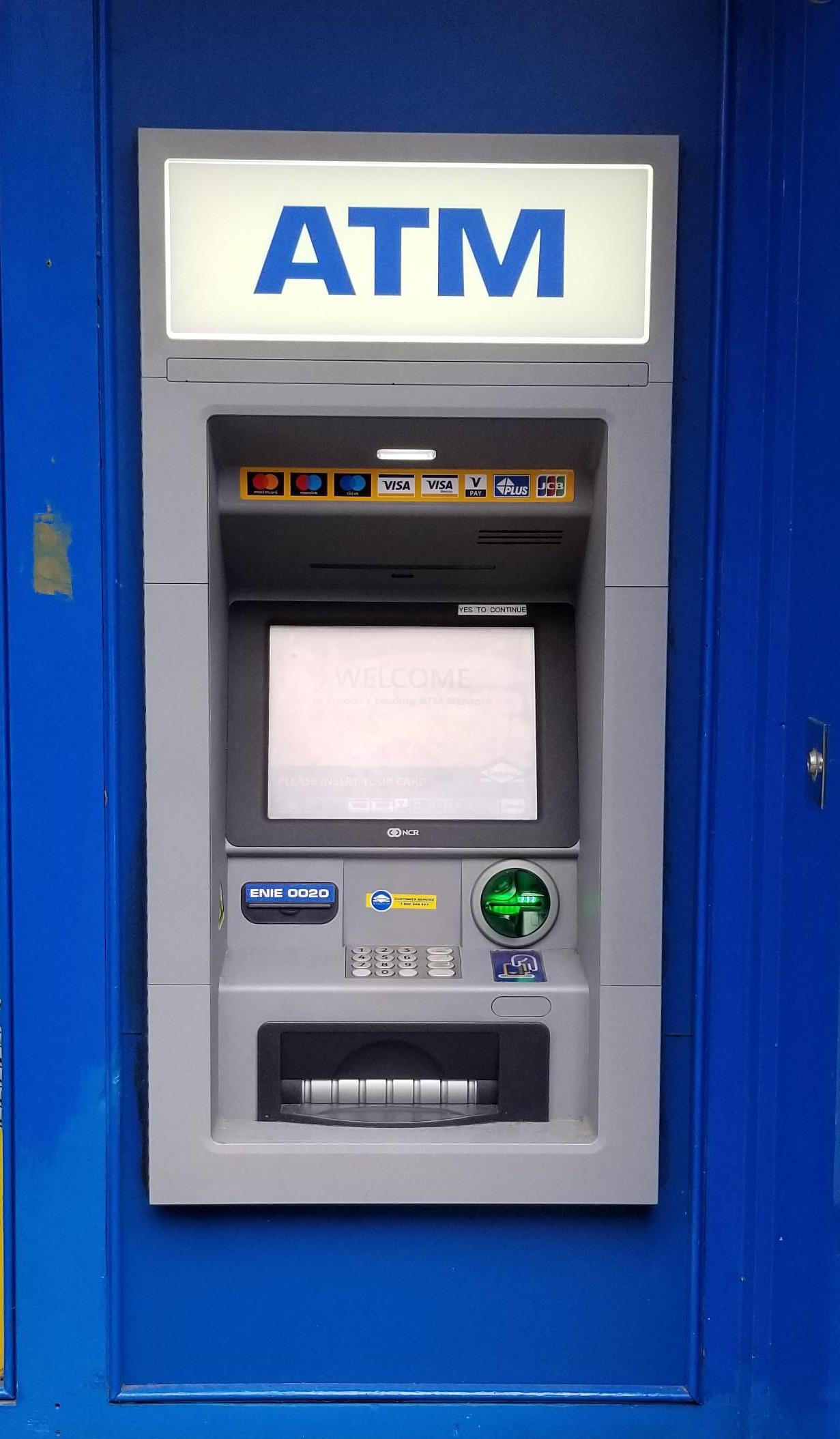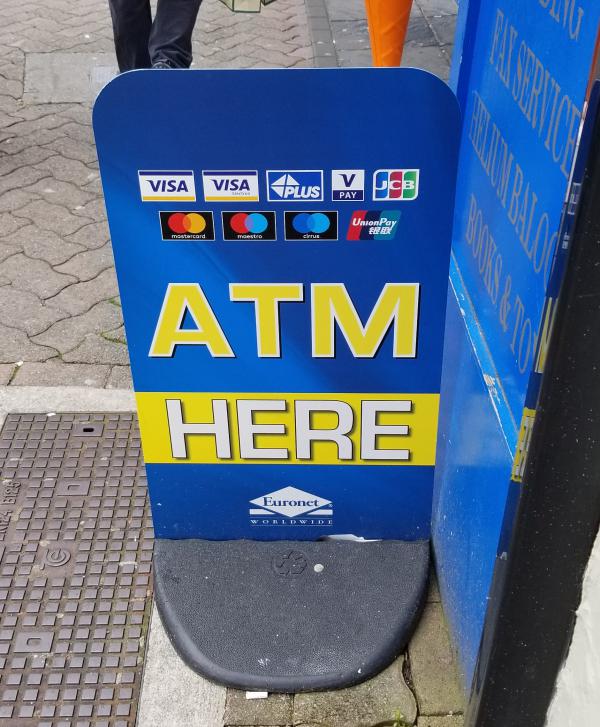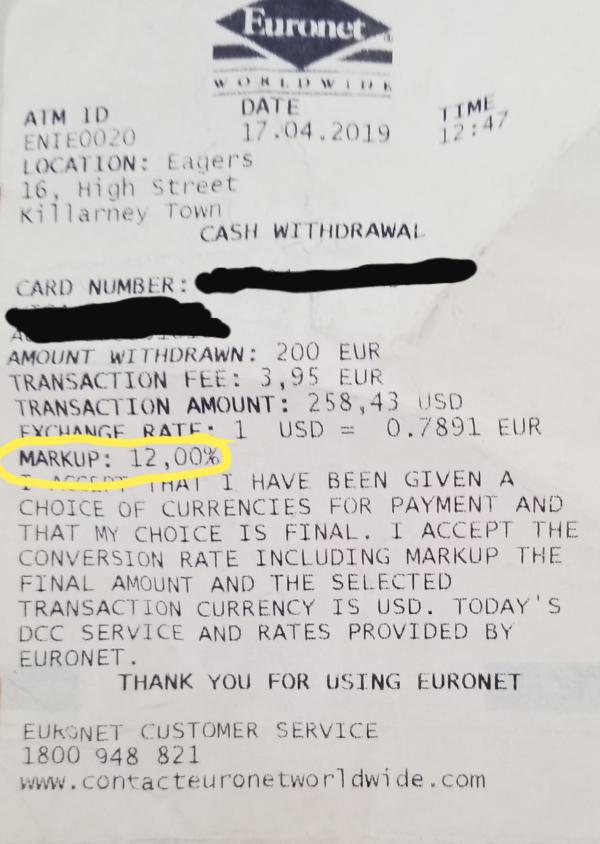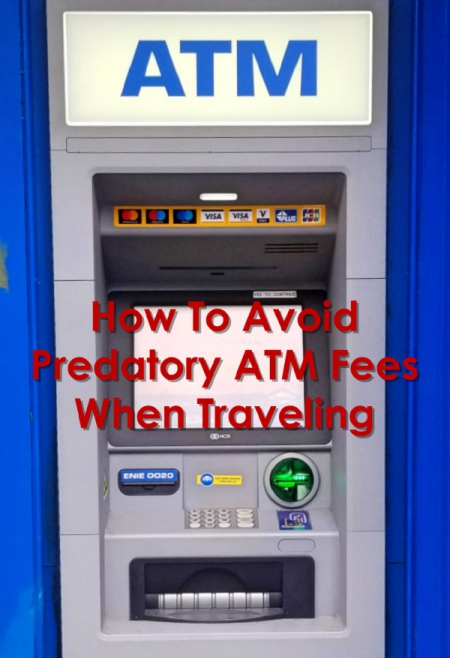
Travel Tip: How to Avoid ATMs with Predatory Fees
I was recently in Ireland and had something happen that I haven’t experienced in more than 30 years of travel to over 40 countries; I fell victim to an ATM with predatory fees. Below I’m going to share some tips on how you can avoid ATMs with predatory fees.
Let me start by saying I accept full responsibility for my mistake and hope that others can learn from it, which is why I’m sharing it here. Lesson learned.
Table of Contents
Getting Money At An ATM In Another Country
We were in Killarney and needed an ATM. The first one we stopped at was at a bank but it did not have the “Plus” symbol we needed. When we passed another ATM and it did, I stopped there.
Look For The Right Symbols
Look at the symbols/signs on the back of your card and match them up with what’s posted on the front of the ATM. Some may be “PLUS”, some may be “CIRRUS”, etc.

While using the ATM, I got a warning of a “transaction fee” of 3.95 euro. This was ok with me because my bank refunds any random “fees” for using any ATM anywhere in the world.
The screen also said there would be a currency conversion rate of $1=.7891 euro and asked me to “accept” it.
This is where they got me, on the conversion.
Be Aware Of The Conversion Rates
I did not take the time to do the math in my head or realize how horrible this rate was. It should have been closer to .896 euros. That may not sound like a big difference, and I didn’t think it was at the time, but it’s 12%.
Being American, I usually think about the conversion in the reverse; 1 euro= $1.12. Again, my fault for not knowing it better in the reverse.
This conversion rate was 1 euro = $1.26 US.
What does this mean? It means that the 200 euro I took out cost me $258.43 when it should have been around $225 (with the transaction fee). I paid a 12% premium to use this ATM because I was not paying attention. That 12% cost me about $25 US.
The paper receipt shows a “Markup: 12%” but that was nowhere on the screen when I accepted the terms. It would have set off alarm bells in my head if it had been there.

In contrast, a few days later we used a bank ATM and 100 euros cost $112 with no crazy “markup fees”. Needless to say, I will be much more careful in the future.
How to Avoid Unreasonable International ATM Fees
- Watch out for “Euronet” or similar stand-alone ATMs. These are sometimes in airports, convenience stores, hotels, and in my example, in a busy town center.
- Whenever possible, use ATMs connected to legitimate banks.
- Read all the disclaimers when using the ATM and hit cancel if anything looks funny.
- Pay attention to fees and exchange rates, if listed.
- Know the current exchange rate backward and forward; how much of your currency equals “1” of the currency you want, and what is “1” of your currency in the currency you are buying. Example; 1 euro=$1.12 OR $1=.896 euro.
- Find out if your bank charges a foreign exchange fee on top of any fees charged by the ATM.
Buying Currency In Advance (Don’t)
I always think it’s a good idea to land with some currency in your pocket of the country you are visiting. Typically you can go to your bank before you leave home and order currency but be aware that this too comes with a cost.
For example, the rate the bank will give you will come with the markup (their profit) built-in. Someone told me they purchased 1000 euro from their bank and it cost them $1212 which means their exchange rate was $1.21. There were no “fees”, but the cost per dollar was much higher than if they’d waited to get euros when in Europe. For them, the convenience was worth it. For me, it’s not. In this example, it might make sense to get 100 or 200 euro rather than spend an extra $9 on every 100 euro. In this example, they spent an extra $92 for convenience.
Keep in mind, if you exchange cash money at an exchange counter at an airport on arrival, you will get a similar poor rate.
(Do) Use Credit Cards Instead Of Cash
While I still think using a local ATM is the best way to get local currency, using a credit card with no foreign transaction fees is often the most convenient option. While we were in Ireland for 8 days, we spent about 300 euros in cash, with the rest of our expenses going on a credit card. That credit card had the same exchange rate as the bank ATM, plus we got points on everything we spent which is a win/win in my book!
TIP: When paying by credit card, if you are asked if you want to pay in the local currency or your home currency, always select the local currency. If you select your home currency, you will likely receive an unfavorable exchange rate with a built-in fee. This is called Dynamic Currency Conversion and this post explains it in more detail.
Pin this post to save for later!

Have you ever fallen for an ATM with predatory fees? Do you have any other tips to add on how to avoid international ATM Fees? Leave a comment below!
Want more Travel Tips? Check out these posts.
Any post on this site may contain affiliate links.
Thank you for supporting wired2theworld by using our links to shop, book hotels, or organize tours. If you use them, they cost you nothing extra but we may make a small commission that helps us to continue to provide helpful and free content.


27 Comments
Sue
Very good points made here! I hate to think about how much I have been charged through the years for just withdrawing my own cash. I always try to use a machine attached to a bank where possible. Thanks for sharing.
wired2theworld
Yes, it was a good reminder for me as well. I thought I knew better…
Lewis peake
All great tips. I also got ripped off by a Euronet ATM recently – €5.95 to withdraw €100 in Spain. I thought I had used it before for free, but will avoid now. There was no warning, which an auditor friend told me is illegal. However, I encountered a new DCC scam in Portugal last courtesy of Millennium Bank. Travellers are told repeatedly always to pay in local currency which I do. But MB have a new line in sharp practice. After you select euros, it asks if you accept the currency conversion. I assumed this question was generated by my bank which charges no commission. But no, this is sneaky way to reverse your previous answer and charge you in your own currency with a hefty mark-up. The bank & merchant split the commission so watch out for merchants who choose euros without giving you a chance to choose for yourself! MB ATMs also charge a fee with no warning.
Lewis Peake
BTW Unicaja ATMs in Spain are currently free; just used one.
Karen
We’ve had troubles with Euronet too. I wont use them on principle. Great tips, thank you. kx
Anita
ATMs in unknown country can be money eaters, so your tip is useful for avoiding it. When I pay with credit card while traveling I always choose a local currence again to avoid unknown conversion rates right away. Thanks for sharing.
wired2theworld
Anita, yes, that’s a good tip about the credit card! I will edit the post to include that.
Paula Morgan
Great advice, finding the right bank can make all the difference. We switched to a fee free international card a few years back for our credit card but even some regular transactions are charged differently on different ATMS. We found one in Greece that charged no extra fees when most of the others were charging 2 or 5 euro. It’s hard to recognise private ATM’s with high charges in foreign countries.
Sue Davies
Very good points here. We are always very careful about ATMs. we also make sure to use local currency when we pay by credit card.
wired2theworld
Thanks! The little stuff certainly adds up, doesn’t it?
Helen
Blimey, I’ve never really paid that much attention to conversion rates but that’s a whopper of an extra fee! Will definitely be more careful in future.
wired2theworld
I know! It shocked me too!
Kit
Sorry you had that happen to you. 🙁 Thank you for sharing though! I’ll been in Europe this summer and will definitely pay attention!
wired2theworld
Believe me, so will I on every trip now!
Coralie
Wow! That’s a horrific mark up! Daylight robbery! I like to think I’m pretty switched on about these things, but I’m not sure I’d have spotted this one, so thank you for taking the time to post your experience.
wired2theworld
Thanks, I thought I would have noticed too. I certainly will from now on! I’ve learned my lesson.
Max Wax
Thanks for an interesting & helpful web site. My contribution is……… I’m from the UK and I just got back from a 2 week trip around central Europe visiting 5 countries. Usually I take enough cash for a trip as I travel to many remote areas where access to Banks & ATMs can be difficult & the locals often only take cash for meals, drinks etc. I usually carry cash as GBP, USD or Euro, depending on what is easiest to exchange. Unusually, on this occasion, near the end of the trip, I needed some additional cash in Poland. I was in a bit of a rush as others were waiting on me so I used my Debit card in a Euronet ATM next to our hotel. I drew out 1,000 PLN, which cost me 231 GBP (figures rounded). However, it was not until I returned home that I noticed on the receipt that this transaction included a “Markup” of 13% + a “Transaction Fee” of 17 PLN. I either wasn’t paying close enough attention, or these charges were not clearly highlighted before the transaction took place. Had I carried out the same transaction in the UK at my usual local travel currency exchange centre the 1,000 PLN would have cost me 211 GBP. In other words I paid charges totalling 20 GBP on a spend of 231 GBP via the Euronet ATM, which I think works out overall at about 8.7% in charges. So, even as a seasoned traveller of 30 years I still got caught out in a moment of distraction. Lesson learned for me; if I need cash use a bank ATM, if that’s not available I need to pay closer attention to all charges (if they are displayed), don’t rush into making a decision as this leads to errors of judgement. Fortunately I changed most of my 1,000 GBP travel money to Euro in the UK which was accepted by most of the countries I visited. When necessary I used local exchange centres (where I got good rates) to the currency of the country I was in at the time. Had I used Euronet to change all of my 1,000 GBP travel money it may have cost me closer to 90 GBP in charges.
wired2theworld
Max- Thanks for sharing your experience! Sorry to hear the same thing happened to you, but at least you aren’t alone!
Amy
So glad I found your article! I was pissed after I fell victim to Euronet – getting some info made me feel a little better! I was also picking USD when using a credit card, thanks for that info too!
wired2theworld
Amy- yes, there’s comfort in knowing you’re not alone when you make mistakes like that, isn’t there? 🙂
Max Wax
Since my last post I’ve been doing some further research on Euronet. If you’re interested, in your browser type “Euronet excessive charges” and you’ll find a flood of reports on how unhappy people are with Euronet charges. I will pass this information on to my family & friends and never use their services again. Of course I will also now keep a much closer eye on other ATM providers as I strongly suspect Euronet are not the only ones up to these shenanigans.
John Brown
I have just returned from a visit to Porto. I thought that I could get through a 4 day visit using my fee free credit card and some Euros left over from one of my regular trips to Spain, where I have a bank account. Being a regular traveler, I am well aware of the contagion that Euronet atms are to the unsuspecting tourist. The concierge at my hotel therefore pointed me in the direction of the Novabank branch close by that then applied a 12.5% commission to my withdrawal and offered a very inferior exchange rate of their own! Local tourist authorities should take a good look at themselves before they let in these networks who skim a significant part of their visitors spending money off in excessive fees.
Jeanna
Just noticed a $52 fee for a $200 atm withdrawal in Rome. I specifically avoided the airport atm this time because they charged me $30 for a $200 withdrawal last year. LOL live and learn (again). I should have asked the hotel concierge. That’s what they are there for. Sounds like someone here had a bad experience with advice from a hotel regarding atms, but most are honest 🙂
Paula
Hi this is a great article. Very useful tips! I’d also suggest another tip – one can save up on the ATM fees by finding the ones that don’t charge any fees compared to others. You can use apps like ATM Fee Saver – it helps finding the fee-free and lower fee Atms in many countries and it also gave me withdrawal limits for foreign card holders. I could save up a fair few dollars with this. worth adding to your list of tricks!
briaanwilliams01
Thanks for sharing these valuable tips on avoiding predatory ATM fees while traveling! Your firsthand experience serves as a cautionary tale for travelers, emphasizing the importance of understanding currency conversion rates and selecting reputable ATMs. These insights will undoubtedly help others navigate international transactions more wisely.
Tiano
The ATM fee directory at atmfeelist.com is another great way to minimize fees when withdrawing cash abroad. Super easy to use and has fees for most popular destinations!
Pingback: